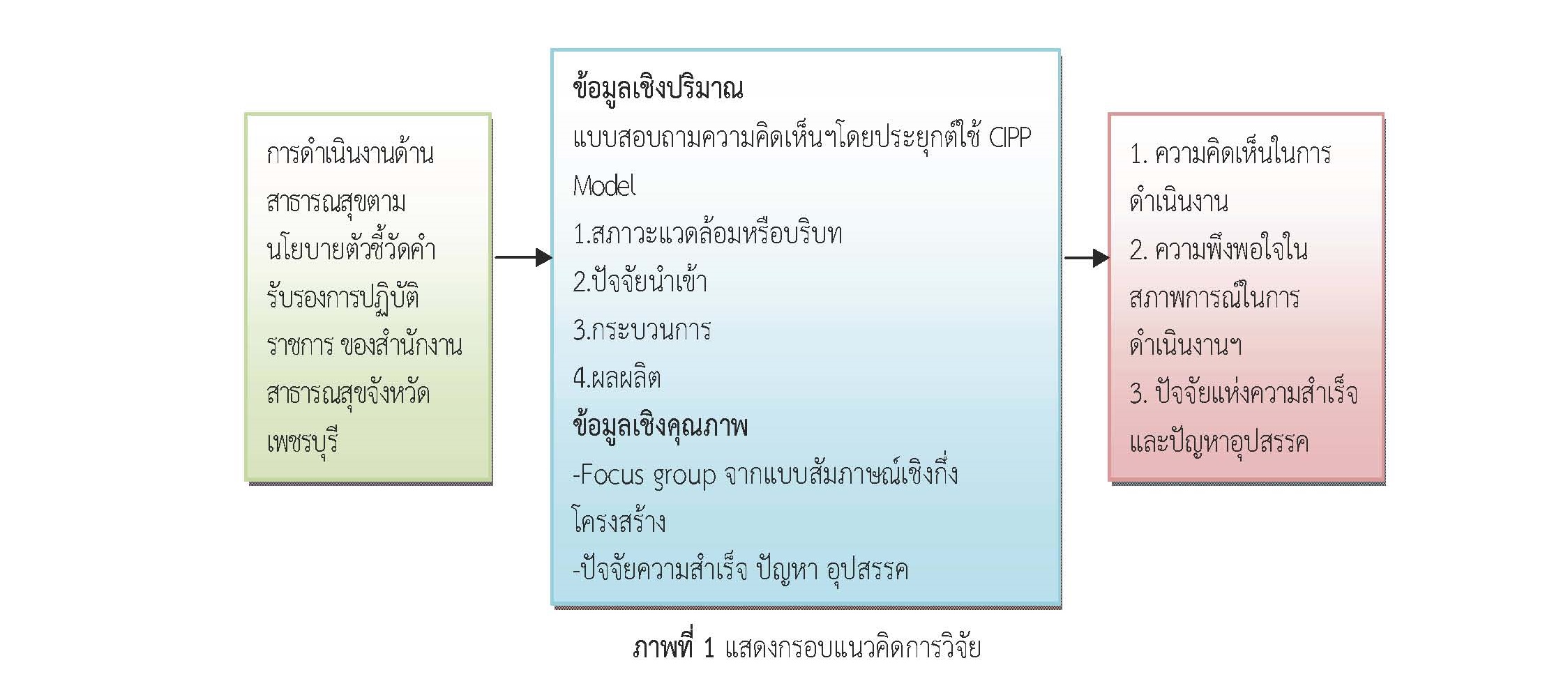Public Health Performance Assessment under the Internal Performance Agreements of Phetchaburi Provincial Public Health Office
Keywords:
Performance Assessment, Internal Performance Agreement, Phetchaburi Provincial Public Health OfficeAbstract
This mixed-method research aimed to evaluate opinions and satisfaction towards the situation of public health performance and investigate facilitating factors, problems, and barriers of performance assessment under the internal performance agreement of Phetchaburi provincial public health office. CIPPP Model was implemented in public health operation in Phetchaburi province. The samples were 78 public health officers who worked in the policy and planning department, Phetchaburi provincial public health office consisting of 22 head of the department and 56 health staffs. Data was collected using opinion and satisfaction towards public health performance questionnaires. Focus groups were used to obtain further information via a semi-structured questionnaire. Quantitative data were analyzed by descriptive statistics such as frequency distribution, percentage, average score and standard deviation. Qualitative data were analyzed by content analysis.
The results showed that the overall public health performance under the internal performance agreement of Phetchaburi provincial public health office passed in all four aspects. The overall mean score of the head of the departments’ opinions was at high level 3.94 (SD= 0.52) and health staffs’ opinions was 3.95 (SD= 0.51). The overall mean score of the head of the departments’ satisfaction was 3.98 (SD= 0.49) and health staffs’ satisfaction was 3.99 (SD= 0.50). Facilitating factors in public health performance were personnel administration, organizational culture, and administration. The problems and barriers in public health performance assessment were too may the performance assessment indicators and difficult to implement as the input factors. Concerning process factor, the assessment guidelines in each team were inconsistent leading to confusion and bias. Moreover, person in charge did not send information back to health staffs for resolving the problem as the planning factor. This study suggests that policy and evaluation model appropriated with context in each area should be developed. The directors should build understanding to all health personnel and develop person in charge and health staffs’ capability such as meeting, training/seminar or explaining about criteria and indicators.
References
กลุ่มพัฒนาระบบบริหาร กรมการแพทย์ กระทรวงสาธารณสุข. (2565). คู่มือการประเมินผลการปฏิบัติราชการตามคำรับรองการปฏิบัติราชการของหน่วยงานในสังกัดกรมการแพทย์ ประจำปีงบประมาณ พ.ศ. 2565.
จุฑาทิพย์ ชมพูนุช. (2564) การประเมินผลการดำเนินงานพัฒนาคุณภาพ NCD Clinic Plus ปี 2562 พื้นที่เขต สุขภาพที่ 5 ในสถานบริการสาธารณสุขของรัฐ สังกัดกระทรวงสาธารณสุข. วารสารควบคุมโรค, 47(2), 300-312.
จิรรัตน์ ธีระวราพฤกษ์. (2553). ปัจจัยแห่งความสำเร็จหลักของการจัดการผลผลิตทั่วทั้งองค์กร (TPM) สำหรับอุตสาหกรรมกระดาษและกล่องกระดาษลูกฟูก. วารสารวิทยาศาสตร์และเทคโนโลยี, 18(2), 83 -95.
งานยุทธศาสตร์และแผนงาน สำนักงานสาธารณสุขจังหวัดเพชรบุรี, (2562). รายงานประจำปี. เพชรบุรี.
ทิพาพรรณ อิ่มสุ่น (2554). ประเมินผลระบบการประเมินผลการปฏิบัติราชการตามพระราชบัญญัติระเบียบข้าราชการ พลเรือนสามัญ พ.ศ. 2551 ที่มีต่อข้าราชการกรมธนารักษ์ (ส่วนกลาง). ภาคนิพนธ์รัฐศาสตรมหาบัณฑิต คณะรัฐศาสตร์, มหาวิทยาลัยธรรมศาสตร์.
บุญธรรม กิจปรีดาบริสุทธิ์. (2553). ระเบียบวิธีการวิจัยทางสังคมศาสตร์. กรุงเทพมหานคร: จามรีโปรดักท์.
ผาสุก สุวรรณจิตต์. (2554). ปัญหาและสภาพการณ์ประเมินผลงานสาธารณสุขหน่วยงานในสังกัดสำนักงานสาธารณสุขจังหวัดชลบุรี. วารสารสุขภาพและวิจัยทางการพยาบาล, 28(2), 19-33.
นันทพัทธ์ ธีระวัฒนานนท์. (2563). การประเมินผลการดำเนินงานสาธารณสุขจังหวัดนครราชสีมา. วารสารวิจัยและพัฒนาสุขภาพ สำนักงานสาธารณสุข จังหวัดนครราชสีมา, 6(1), 90-107.
นงณภัทร รุ่งเนย. (2563). รูปแบบการพัฒนาความฉลาดทางสุขภาพในการป้องกันโรคหลอดเลือดสมองของผู้ป่วยกลุ่มเสี่ยงสูงในหน่วยบริการปฐมภูมิ จังหวัดเพชรบุรี. วารสารแพทย์เขต 4-5, 39(3), 344-363.
ไพศาล วรคำ. (2559). วิจัยทางการศึกษา (พิมพ์ครั้ง 8). มหาสารคาม: ตักกะศิลการพิมพ์.
วาสิตา บุญสาธร, (2563). ระเบียบวิธีวิจัยสำหรับการพัฒนาทรัพยากรมนุษย์และองค์กร. กรุงเทพฯ: คณะพัฒนาทรัพยากรมนุษย์ สถาบันบัณฑิตพัฒนบริหารศาสตร์.
วิพรรณ ประจวบเหมาะ, นภาพร ชโยวรรณ, มาลินี วงษ์สิทธิ์, ศิริวรรณ ศิริบุญ, วรเวศม์ สุวรรณระดา, วิราภรณ์ โพธิศิริ, และคณะ. (2556). รายงานการศึกษาโครงการติดตามและประเมินผลการ ดำเนินงานตามแผนผู้สูงอายุแห่งชาติ ฉบับที่ (พ.ศ. 2545-2564) ระยะที่ 2 (พ.ศ.2550-2554). กรุงเทพฯ: วิทยาลัยประชากรศาสตร์ จุฬาลงกรณ์มหาวิทยาลัย.
วีระศักดิ์ เครือเทพ (2558). 9 กฎเหล็กสำหรับการบริหารจัดการที่ดีขององค์กรปกครองส่วนท้องถิ่น. วารสารสังคมศาสตร์, 11(1), 5-27.
ศุภามณ จันทร์สกุล. (2556). ยุคสมัยของการประเมินผลและแนวคิดทฤษฎีของนักประเมิน. วารสารวิชาการมหาวิทยาลัยอีสเทิร์นเอเชีย ฉบับวิทยาศาสตร์และเทคโนโลยี, 8(1), 68-79.
สมยศ ศรีจารนัยและคณะ. (2557). วิจัยประเมินผลการดำเนินงานตามนโยบายทีมหมอครอบครัว. สำนักนโยบายและยุทธศาสตร์, สำนักงานปลัดกระทรวงสาธารณสุข: โรงพิมพ์ชุมนุมสหกรณ์การเกษตรแห่งประเทศไทย จำกัด.
สํานักบริหารการสาธารณสุข. การ ขับเคลื่อนระบบสุขภาพระดับอําเภอ (รสอ.) District Health System (DHS) ฉบับประเทศไทย. นนทบุรี: สํานักงาน ปลัด กระทรวงสาธารณสุข.
องอาจ นัยพัฒน์. (2558). การประเมินผลการปฏิบัติงานของบุคลากรในสถาบันอุดมศึกษา : กรอบแนวคิดและแนวทาง ปฏิบัติเพื่อการพัฒนา. วารสารการวัดผลการศึกษา มหวิทยาลัยมหาสารคาม, 21(1), 15-33.
อุทัยวรรณ สุกิมานิล. (2557). การบริการปฐมภูมิ. นครปฐม: กลอยการพิมพ์.
Chanikamas Netjuy. (2012). Public Sector Performance Management: A Case Study of Departments with Missions Concerning Economic Development. Dissertation thesis: Ramkhamhaeng University. [In Thai]
Klein, A. S., Wallis, J. & Cooke, R. A. (2013). “The impact of leadership styles on Organizational culture and firm effectiveness: An empirical study.” Journal of Management & Organization, 19(3), 241-254.
Stufflebeam andShinkfield. (2007). Evaluation Theory, Models and Applications. JohnWiley and Son, Ine.
Waal, A. A. (2003). “Behavioral factors important for the successful implementation and use of performance management systems.” Management Decision, 41(8), 688-697. [In Thai]

Downloads
Published
How to Cite
Issue
Section
License
1. บทความหรือข้อคิดเห็นใด ๆ ที่ปรากฏในวารสารวิจัยการพยาบาลและการสาธารณสุข ที่เป็นวรรณกรรมของผู้เขียน บรรณาธิการไม่จำเป็นต้องเห็นด้วย
2. บทความที่ได้รับการตีพิมพ์ถือเป็นลิขสิทธิ์ของ วารสารวิจัยการพยาบาลและการสาธารณสุข








